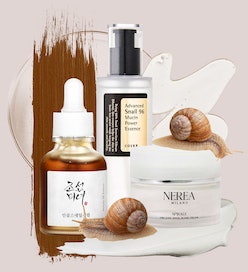(Back To Basics)
Snail Mucin Is The Ingredient To Try If You’re Chasing After Glass Skin
Rich in nutrients and hyaluronic acid.

With new products, brands, and categories popping up every day, beauty can be a bit overwhelming. Back to Basics is our rudimentary beauty series that serves as your crash course on the science behind some of the best formulations in the game. This week, we’re taking a look at snail mucin for your skin.
Slugging, the method of layering an occlusive product on top of creams to seal in moisture, was among the buzziest skin care trends of 2022. From beauty editors to TikTokers, the technique was everywhere, and despite having nothing to do with the insect it was named after, it was hard not to conjure thoughts of the slippery bug when talking about it. But the idea of smothering your skin with layers of emollients was just the starting point for slugs in beauty. Recently, there’s been an uptick of interest in the slimy substance it leaves behind. That’s right: The skin benefits of snail mucin have made natural slime a hot topic for anti-aging, collagen production, and skin preservation.
If your first thought is to cringe at the notion of rubbing snail leftovers on your face, that’s understandable. But in reality, the naturally-derived substance makes an excellent skin care ingredient because it boasts components renowned for their benefits, such as glycoproteins, and hyaluronic acid. Despite snail mucin recently gaining mainstream attention, it’s been a staple in Korean skin care for years, with brands like COSRX building entire collections around it.
Ahead, TZR tapped two dermatologists and a cosmetic chemist for the full scoop on snail mucin, including how to use it and the best products to add to your current routine.
What Is Snail Mucin?
Snail mucin, also known as snail mucus or snail slime, is essentially the secretion that tails the animal as it moves. Produced to keep the body of the snail from drying out, the mucin is discharged from its underside via special glands. According to Dr. Nazanin Saedi, MD, a Philadelphia-based board-certified dermatologist, it’s often released when the animal is under stress, and it has many protective properties that help repair and hydrate its skin.
What Are The Skin Care Benefits Of Snail Mucin?
For snails, mucin helps keep soft tissue hydrated and retain moisture. Those same benefits ring true for human skin. Dr. Sheila Farhang, MD, board-certified dermatologist and founder of Avant Dermatology in Tucson, Ariz., tells TZR that, “the substance is comprised of a mix of hydrating ingredients, such as hyaluronic acid, proteoglycans, proteins, enzymes, peptides, and minerals, all of which aid in moisturizing the skin.”
In addition to hydrating, the anti-aging properties of snail mucin make it effective in smoothing fine lines, minimizing wrinkles, and improving elasticity. “Many of the main compounds found in mucin aid in skin regeneration and healing, reducing the appearance of fine lines, wrinkles, and even scars,” says David Petrillo, cosmetic chemist and founder of beauty and personal care brand Perfect Image.
Cosmetic benefits aside, Petrillo tells TZR that snail slime is also soothing and anti-inflammatory, so it can help calm irritated skin and the associated side effects, such as swelling.
What Skin Types Should Use Snail Mucin?
Given that moisture retention is the main benefit of the ingredient, snail mucin works extremely well for those with dehydrated or mature skin. “For these skin types, the hydrating properties will replenish the skin and work to ward off future dryness,” says Petrillo. Sensitive and reactive skin (those who experience irritation from fragrance or harsh ingredients) will also find snail mucin useful.
However, Dr. Farhang does note that while oily types can certainly use products containing the ingredient, it may not be as effective as it is for someone whose skin is consistently parched.
How To Incorporate Snail Mucin Into Your Daily Routine
Petrillo explains that, thanks to a variety of products, incorporating snail mucin into your routine is actually pretty easy to do. The ingredient can be found in serums, essences, and moisturizers, so it’s really about finding the right vehicle for your current regimen. “After cleansing your skin with a gentle face wash and applying a toner to balance the pH level, gently massage a small amount of snail mucin (in a serum or cream form) into your skin and follow with your regular moisturizer to seal the benefits and provide additional hydration,” he says.
On a similar note, Dr. Saedi recommends adding serums or moisturizers made with the ingredient into your evening skin care routine. “Skin cells repair themselves at night so using a snail mucin-incorporated product just before bed will assist in replenishment and hydration as you sleep.”